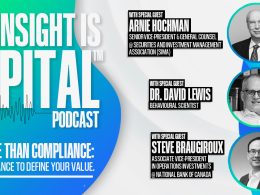Building a Great Culture in Your Firm
by Commonwealth Financial Network
 It was an ordinary day at the office when the call came in. A client was ill and had been admitted to the hospital. Unfortunately, this same client was waiting on an important transaction, and his signature was needed on the paperwork. Since the client couldn’t come to them, the staff person who took the call went to the hospital, getting the needed signature.
It was an ordinary day at the office when the call came in. A client was ill and had been admitted to the hospital. Unfortunately, this same client was waiting on an important transaction, and his signature was needed on the paperwork. Since the client couldn’t come to them, the staff person who took the call went to the hospital, getting the needed signature.
This example demonstrates what can happen when a firm is passionately committed to helping its clients. Specifically, when the values that drive a firm’s culture are clearly defined and understood, it empowers staff to act in a manner that is consistent with those values. Of course, there are many things that lead to successful practices (e.g., a strong business strategy, an effective service model). But one of the key ingredients for the most successful firms is having a positive culture. Simply put, building a great culture in your firm can drive great results.
Let’s start by defining culture. Here’s one commonly accepted definition:
The set of shared, taken-for-granted implicit assumptions that a group holds and that determines how it perceives, thinks about, and reacts to its various environments.
You can measure your firm’s culture through goals, such as performance levels and employee retention. For example, if growth is one of your goals, create a culture that focuses on tactical actions that affect the performance, people, and alignment within the firm. But whatever your goals, it’s your responsibility as firm leader to put these words into action with the help of your core resource: your staff.
Staff members are the major players in your value proposition. On the front lines each day, they often work directly with your clients. Do they understand what you consider outstanding client service and how it’s measured? This is vital information if they are expected to deliver on expectations. Further, it’s this basic understanding that helps them develop ideas for enhancing the client experience. When your team begins to fully understand how they contribute to profitability, they have taken a major step toward personal accountability and the performance of the firm.
Let’s look at three steps you can take to create a culture where people treat one another well and embrace the behaviors that are critical for success.
1) Choose the right people. A critical step to building a great culture in your firm is to surround yourself with the right people. You need people who not only have the necessary skills but will align with your values. For someone to be successful in your firm, he or she needs both skills and cultural fit—don’t compromise on either.
2) Encourage innovation. If your culture supports the status quo, innovation will be stifled, and revenue and other key performance metrics will begin to lag. Instead, keep in mind that certain factors will change over time (e.g., technology and industry regulations), so the systems and processes that support your culture will need to change as well.
Think about what would happen if you created a culture in which staff members are encouraged to treat mistakes as learning opportunities. You just might find that by showing a willingness to try something different, staff will be more likely to respond in a way that supports the culture.
3) Keep employees engaged. Every year in the U.S., lost productivity from employee disengagement costs an estimated $300 billion! This disengagement can lead to turnover, which is both costly and disruptive.
Help keep employee engagement high by giving staff the opportunity to complete work that is meaningful. Start by taking the time to explain to them why you do what you do. People want to work for a firm that has purpose and meaning. If you align staff with your mission, you can nurture more dedicated and productive employees.
Once your team understands the impact you’re trying to make, give them the freedom to execute. For instance, allow them the autonomy to complete tasks in the way that works best for them. The result will be employees who are more likely to perform at a higher level.
In short, everyone on your team should be on the same page. So, how do you get there?
Meet regularly. Consider conducting a quarterly meeting to:
- Review business goals
- Update staff on firm initiatives
- Share performance information (e.g., client retention, new client acquisition)
Presenting this data on a regular interval is an effective way to demonstrate to staff how their actions affect the firm.
Foster collaboration. Successful firms collaborate with and solicit feedback from staff on new and better ways to deliver value. But sharing happens only if staff feel free to speak their minds and are excited about what they are doing. If your employees feel that they are included and are genuinely heard, they are going to have a more vested interest in your firm.
Conduct regular performance appraisals. Providing feedback on a regular basis can effectively reinforce the “right” behaviors—those that align with the firm’s meaning and purpose. In turn, it helps create a sense of belonging, higher productivity, and more effective employees.
Training and development. Your staff members want to develop their skills and enhance their contributions. Training and development provides this opportunity—giving employees greater ownership of their responsibilities and contributing to loyalty and retention.
Once you’ve built the foundation for a strong culture, don’t neglect it! That culture needs to be maintained and nurtured.
- Implement a management system for priorities and goals. Many firms have a system in place to track priorities and goals. But that system should be adjusted to focus more time and attention on the top performance priorities: achieving the desired results and supporting the behaviors (e.g., recognition, coaching) that create those results.
- Manage communication. Consistent communication is vital to ensuring that all employees feel they are part of the process. Your quarterly meetings and one-on-one meetings with staff provide the perfect opportunity to discuss specific goals and results, plus clarify plans and answer questions.
- Build motivation. Feedback and recognition are critical components of culture. Achievements, both large and small, should be shared and celebrated. When things don’t go as planned? Then meet with staff to reengage them and prioritize the changes that are needed.
Culture will always be a part of your firm, whether through focused effort or as a natural by-product of how you run your business. I encourage you to take the time to reflect on your firm’s culture, keeping in mind that change won’t happen overnight. But with tenacity, creativity, and the energy that can come from working with the right people, you will be on your way to building a great culture in your firm and producing great results.
What system do you have for tracking priorities and goals? What components do you see as the most valuable to building a firm’s culture? Please share your thoughts with us below!
Commonwealth Financial Network is the nation’s largest privately held independent broker/dealer-RIA. This post originally appeared on Commonwealth Independent Advisor, the firm’s corporate blog.
Copyright © Commonwealth Financial Network

















